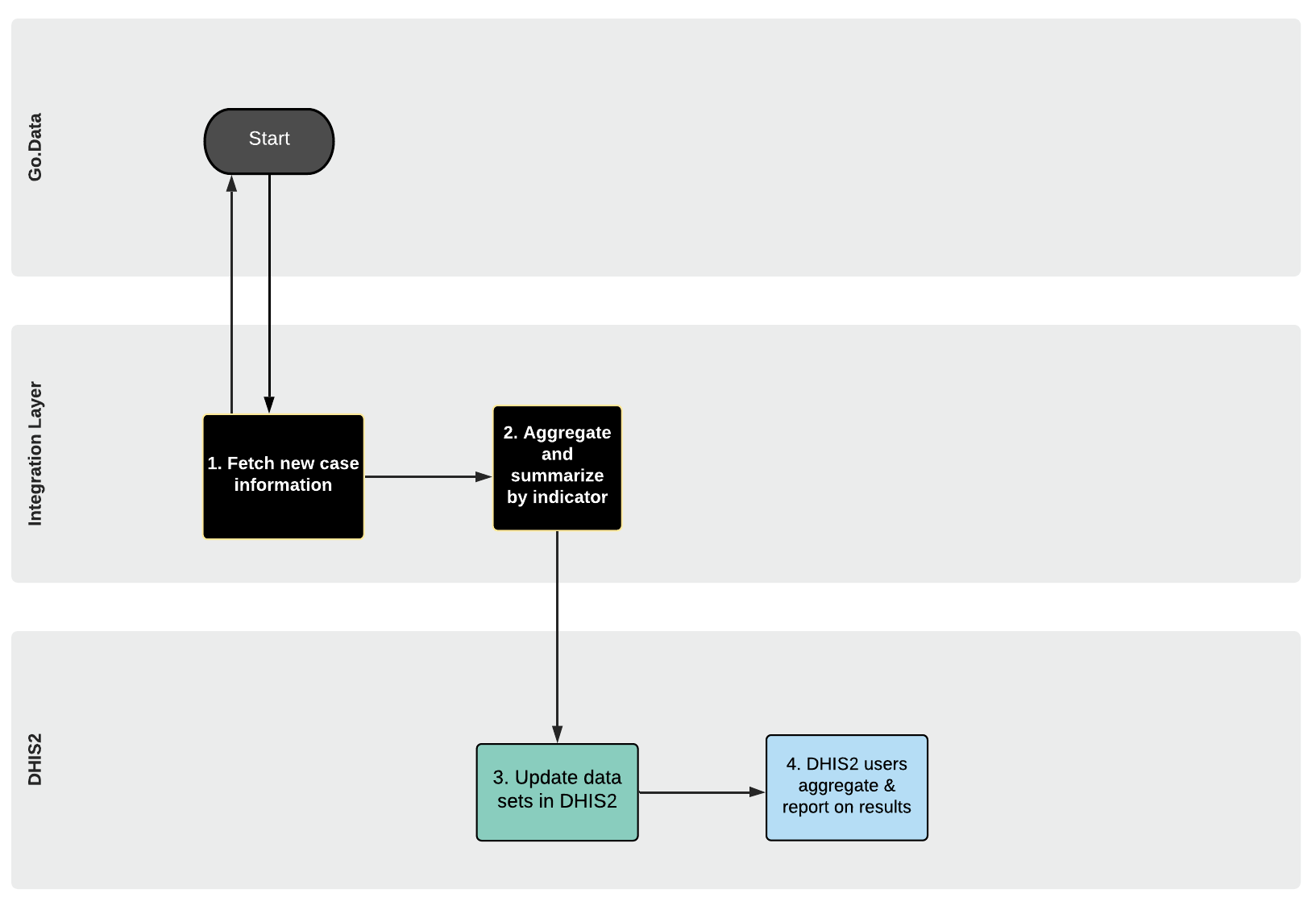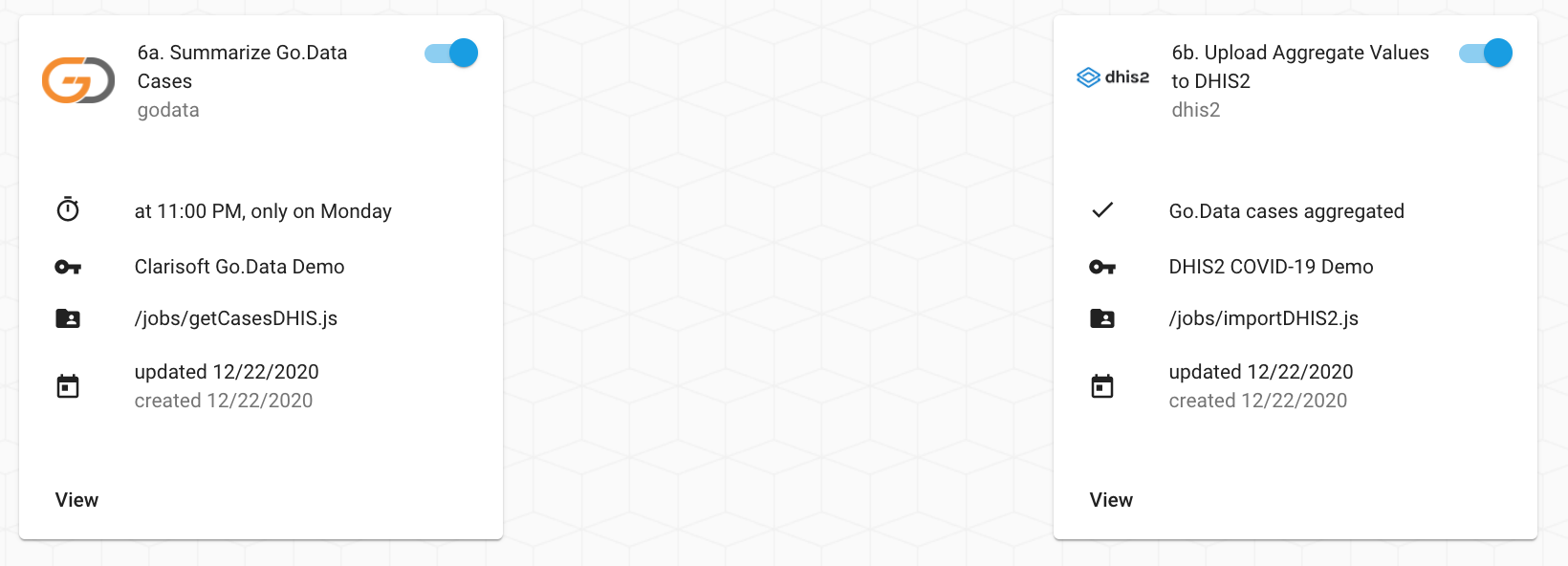Aggregate Reporting to DHIS2
Reporting out from Go.Data to an external HMIS/reporting system is a very popular requirement among implementers, particularly the need to report aggregate/ summary results for key indicators (e.g., # of cases confirmed this week, # of cases hospitalized).
Go.Data plans to expand its API to support extraction of automatically aggregated results for common indicators. In the meantime, users can also leverage the Go.Data API (see API docs to (1) list individual records, and then (2) write a script to sum/aggregate these records before (3) uploading to an external reporting system like DHIS2. We explore this data flow in this below reference implementation with DHIS2.
- See Integration with DHIS2 page for other DHIS2 integration scripts developed by UPC and other partners, along with more guidance for DHIS2 integrations.
- Watch the video overview
- Explore the Implementation

Use Case: #6. As a MOH employee using DHIS2, I would like to receive a weekly summary of Go.Data data cases to monitor performance across key COVID-19 indicators (e.g., # confirmed cases, # hospitalized cases, transmission classifications).
Solution Overview
–> Watch the video overview
Many Go.Data implementers have reported that they are required to regularly report summary results to their national-level HMIS, many of which use DHIS2 for country-level reporting and monitoring. Therefore, in this reference implementation we integrated Go.Data with the DHIS2 COVID-19 demo org, summarizing Go.Data Cases and uploading them as dataValueSets into DHIS2 for aggregate indicator reporting. See the below data flow diagram.
- DHIS2 is a popular open-source health information system implemented in several countries worldwide, and provides features for individual- and aggregate-level health record tracking, managament, and analysis. DHIS2 also provides features for common HMIS use cases like the COVID-19 Surveillance Package.
- DHIS2
Indicators(read more here) are a core unit of aggregate analysis and are based ondata elements. - We leverage the Go.Data
/casesAPI endpoints to list, filter, and extractCasedata to then aggregate before uploading to DHIS2data elements.

Integration Scripts
See the Github repo for the raw source code for the following 2 OpenFn job scripts:
- Job 6a-getCasesDHIS.js that gets cases from Go.Data & aggregates individual records to calculate indicator results.
- Job 6b-importDHIS2.js that uploads aggregated results to DHIS2 as
Data Value Sets, which link to aggregate indicators.
On OpenFn.org, we configured a cron timer (e.g. 00 23 * * 1) to run the jobs every 1 week on Mondays to automate the reporting cycle end-to-end.

Implementation Steps
–> Watch the setup walkthrough
-
First determine the reporting requirements and how to extract data from Go.Data. Are you reporting on
CasesorContacts? What attributes will you need to summarize or aggregate results by? Consider what specific data elements you will need to extract and the formulas for different calculations needed (e.g.,COUNT,SUM,AVG, etc.). -
Then determine the key data model attributes of the DHIS2 system you would like to integrate with. Are you integrating with DHIS2
trackedEntities? OrdataValueSetsanddataElements? WhichorgUnitand reportingperiodshould data map to? → See Integrating with DHIS2 for more information on identifying different DHIS2 elements when desiging a new integration. - Map relevant data elements from the Go.Data response to relevant DHIS2 attributes. See mapping specifications and see Integrating with DHIS2 docs section for more guidance on the DHIS2 data model and integration considerations.
- Extract relevant data elements from Go.Data per the requirements in step
#1. In this OpenFn job 6a-getCasesDHIS.js, we send aGETrequest to the Go.Data API to list and extractCasesthat are'confirmed'.
getCase(
'3b5554d7-2c19-41d0-b9af-475ad25a382b', //outbreak Id
{
where: {
classification:
'LNG_REFERENCE_DATA_CATEGORY_CASE_CLASSIFICATION_CONFIRMED', //filter to extract only confirmed cases
},
},
In this same job, we also calculate “summary” results to report to DHIS2. To determine the # of confirmed cases to report to DHIS2, in [L46]https://github.com/WorldHealthOrganization/godata/blob/master/interoperability-jobs/6a-getCasesDHIS.js#L46-L49) we count the number of records returned by our GET request and determine the dateOfReporting.
summary = {
dateOfReporting: lastDateOfReporting,
value: currentCases.length,
};
- We then run another OpenFn job 6b-importDHIS2.js to import this “summary” data into DHIS2 via the API endpoint
/api/dataValueSets.- We follow the DHIS2 API docs to determine other required attributes, such as
orgUnitanddataElementId. - We leverage the OpenFn DHIS2 API adaptor helper function to access the
dataValueSetsresource.
- We follow the DHIS2 API docs to determine other required attributes, such as
//Example job snippet to upload data value sets to DHIS2
dataValueSet({
dataSet: "kIfMNugiTgd",
orgUnit: "DiszpKrYNg8",
period: dateOfReporting, //we dynamically fill based on Go.Data extract
completeData: dateOfReporting,
dataValues: [
dataElement("CnPsS2xE8UN", summaryValue), //we dynamically fill based on Go.Data extract & calculation
]
});
Other DHIS2 Resources
- See the Integrating with DHIS2 for more on Go.Data integrations with DHIS2.
- Read more about Go.Data-DHIS2 integration use cases as part of the UPC project where some DHIS2 to Go.Data scripts have been drafted: https://www.essi.upc.edu/dtim/projects/COVID-19
- See DHIS2 documentation for more on aggregate reporting & API docs: https://docs.dhis2.org/2.34/en/dhis2_implementation_guide/integration-concepts.html#aggregate-and-transactional-data
Explore the Implementation
- See the Explore OpenFn page to explore the jobs on the live reference project.
- Watch the video overview
- Watch the setup walkthrough
- And see here for other interoperability videos
-
DHIS2: Here we integrated with the public
COVID-19 Demoinstance: https://covid19.dhis2.org/demo -
Job scripts: See the Github
interoperability-jobsto explore the source code used to automate these flows. These leverage an open-source Go.Data API wrapper - the OpenFn adaptorlanguage-godata, as well as the DHIS2 API adaptor language-dhis2 - Solution Design Documentation: See this folder] for the data flow diagram & data element mapping specifications mentioend above and used to write the integration jobs.